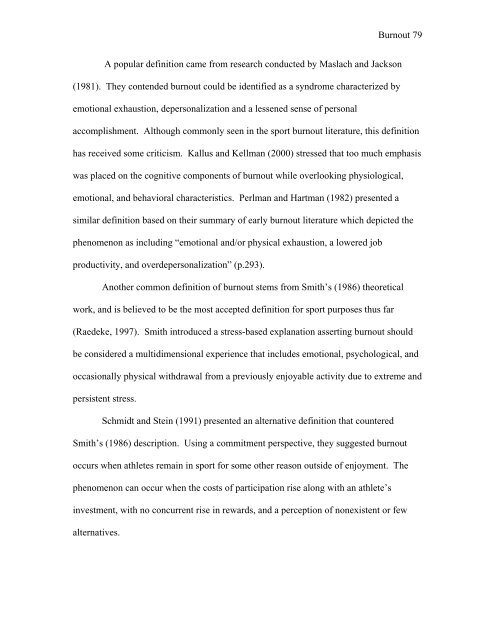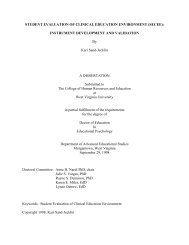Coach and Athlete Burnout - West Virginia University
Coach and Athlete Burnout - West Virginia University
Coach and Athlete Burnout - West Virginia University
You also want an ePaper? Increase the reach of your titles
YUMPU automatically turns print PDFs into web optimized ePapers that Google loves.
<strong>Burnout</strong> 79<br />
A popular definition came from research conducted by Maslach <strong>and</strong> Jackson<br />
(1981). They contended burnout could be identified as a syndrome characterized by<br />
emotional exhaustion, depersonalization <strong>and</strong> a lessened sense of personal<br />
accomplishment. Although commonly seen in the sport burnout literature, this definition<br />
has received some criticism. Kallus <strong>and</strong> Kellman (2000) stressed that too much emphasis<br />
was placed on the cognitive components of burnout while overlooking physiological,<br />
emotional, <strong>and</strong> behavioral characteristics. Perlman <strong>and</strong> Hartman (1982) presented a<br />
similar definition based on their summary of early burnout literature which depicted the<br />
phenomenon as including “emotional <strong>and</strong>/or physical exhaustion, a lowered job<br />
productivity, <strong>and</strong> overdepersonalization” (p.293).<br />
Another common definition of burnout stems from Smith’s (1986) theoretical<br />
work, <strong>and</strong> is believed to be the most accepted definition for sport purposes thus far<br />
(Raedeke, 1997). Smith introduced a stress-based explanation asserting burnout should<br />
be considered a multidimensional experience that includes emotional, psychological, <strong>and</strong><br />
occasionally physical withdrawal from a previously enjoyable activity due to extreme <strong>and</strong><br />
persistent stress.<br />
Schmidt <strong>and</strong> Stein (1991) presented an alternative definition that countered<br />
Smith’s (1986) description. Using a commitment perspective, they suggested burnout<br />
occurs when athletes remain in sport for some other reason outside of enjoyment. The<br />
phenomenon can occur when the costs of participation rise along with an athlete’s<br />
investment, with no concurrent rise in rewards, <strong>and</strong> a perception of nonexistent or few<br />
alternatives.












